The divide wall:
1. The divide wall is a masonry or concrete wall constructed at a right angle to the axis of the weir.
2.The divide wall extends on the upstream side beyond the beginning of the canal head regulator; and on the downstream side, it extends up to the end of the loose protection of the under-sluices.
3.The divide wall is a long wall constructed at right angles in the weir or barrage, it may be constructed with stone masonry or cement concrete. On the upstream side, the wall is extended just to cover the canal head regulator and on the downstream side, it is extended up to the launching aprons.
The main functions of the divide walls:
1. It separates the ‘under-sluices’ with lower crest level from the ‘weir proper’ with higher crest level.
2. It helps in providing a comparatively less turbulent pocket near the canal head regulator, resulting in deposition of silt in this pocket and, thus, to help in the entry of silt-free water into the canal.
3. It helps to keep cross-current, if any, away from the weir.
Fish Ladder
It is a device by which the flow energy can be dissipated in such a manner as to provide smooth flow at sufficiently low velocity, not exceeding 3 to 3.5 m/s.
A narrow opening including suitable baffles or staggering devices in it is provided adjacent to the divider wall.
The fish ladder is provided just by the side of the divide wall for the free movement of fishes. Rivers are an important source of fishes.
There are various types of fish in the river. The nature of the fish varies from type to type. But in general, the tendency of fish is to move from upstream to downstream in winters and from downstream to upstream in monsoons. This movement is essential for their survival. Due to the construction of the weir or barrage, this movement gets obstructed and is detrimental to the fishes.
In the fish ladder, the fable walls are constructed in a zigzag manner so that the velocity of flow within the ladder does not exceed 3 m/sec
The width, length, and height of the fish ladder depend on the nature of the river and the type of the weir or barrage.
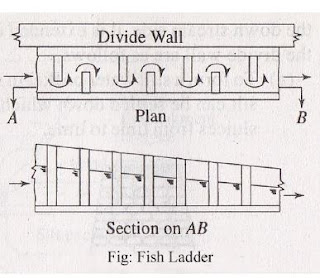 |
| fish ladder, |
Canal Head Regulator or Head sluices
A structure which is constructed at the head of the canal to regulate flow of water is known as canal head regulator. It consists of a number of piers which divide the total width of the canal into a number of spans which are known as bays. The piers consist of number tiers on which the adjustable gates are placed.
The gates are operated form the top by suitable mechanical device. A platform is provided on the top of the piers for the facility of operating the gates. Again some piers are constructed on the down stream side of the canal head to support the roadway.
Functions of Canal Head Regulator:
o It regulates the supply of water entering the canal
o It controls the entry of silt in the canal
o It prevents the river-floods from entering the canal
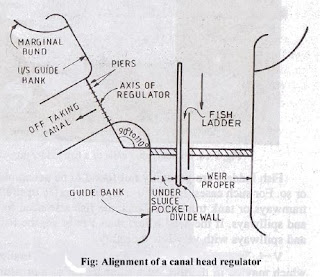 |
| Alignment of a canal head regulator |
The water from the under-sluice pocket is made to enter the regulator bays, so as to pass the full supply discharge into the canal. The maximum height of these gated openings, called head sluices will be equal to the difference of Pond Level and Crest Level of the regulator.
The entry of silt into the canal is controlled by keeping the crest of the head regulator by about 1.2 to 1.5 meters higher than the crest of the under-sluices.
If a silt-excluder is provided, the regulator crest is further raised by about 0.6 to 0.7 meter.
Silt gets deposited in the pocket, and only the clear water enters the regulator bays.
The deposited silt can be easily scoured out periodically, and removed through the under-sluice openings.
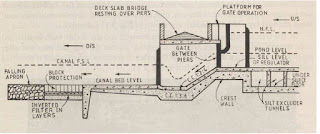 |
| Fig: A typical section through a Canal Head Regulator (CHR) |
River Training Works
River training works are required near the weir site in order to ensure a smooth and an axial flow of water, and thus, to prevent the river from outflanking the works due to a change in its course.The river training works required on a canal headwork are:
(a) Guide banks
(b) Marginal bunds
(c) Spurs or groynes
(a) Guide Bank
When a barrage is constructed across a river that flows through the alluvial soil, the guide banks must be constructed on both the approaches to protect the structure from erosion. Guide bank serves the following purposes:
It protects the barrage from the effect of scouring and erosion.
It provides a straight approach towards the barrage.
It controls the tendency of changing the course of the river.
It controls the velocity of flow near the structure.
(b) Marginal Bunds
The marginal bunds are earthen embankments that are constructed parallel to the river bank on one or both the banks according to the condition. The top width is generally 3 m to 4 m. The side slope on the riverside is generally 1.5: 1 and that on the countryside is 2:1. The marginal bunds serve the following purposes:
It prevents the flood water or storage water from entering the surrounding area which may be submerged or may be waterlogged.
It retains the flood water or storage water within a specified section
It protects the towns and villages from devastation during heavy flood.
It protects valuable agricultural lands.
(c) Spurs or groynes
(i) Spurs
These are temporary structures permeable in nature provided on the curve of a river to protect the river bank from erosion. These are projected from the river bank towards the bed making angles 60o to 75o with the bank of the river. The length of the spurs depends on the width of the river and the sharpness of the curve. The function of the spurs is to break the velocity of flow and to form a water pocket on the upstream side where the sediments get deposited. Thus the reclamation of land on the river bank can be achieved. The spurs may be of the following types:
(a) Bamboo Spur
(b) Timber Spur
(c) Boulder Spur
(a) Bamboo Spur: In this type of spur, a box like a compartment is prepared by driving bamboo piles at 15 cm centre to centre. The piles are secured by bamboo bracings. The hollow space is filled up with sand bags. It is permeable in nature and water can seep through its body. This type of spur is suitable for small rivers. This is purely temporary and requires repair work every year. The length of bamboo piles depends on bed condition.
 |
| Bamboo Spur and timber spur |
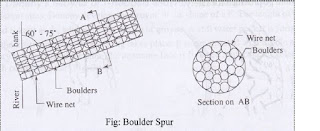 |
| Boulder Spur |
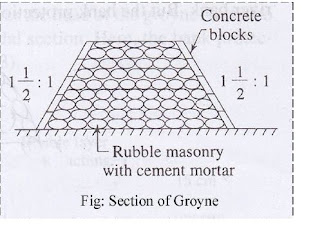 |
| Groynes |
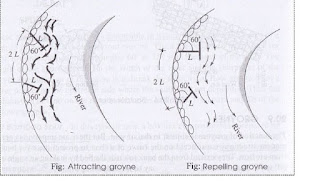 |
| Attracting groyne and repelling groyne |
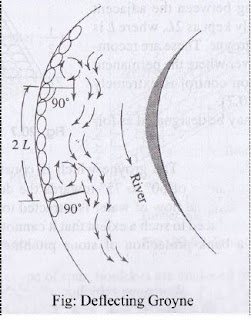 |
| Deflecting groyne |
Modification of Groyne:
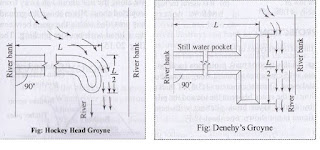 |
| Hockey Head Groyne and Denehy's Groyne |
Comparison between spur and groyne
|
Spur
|
Groyne |
|
It
is a temporary structure. |
It
is a permanent structure. |
|
It is permeable. |
It is impermeable. |
|
It
is constructed with the bamboo pile, timber pile |
It is constructed with rubble masonry
with a sand bag, boulders etc. cement mortar. |
|
It requires repair works. |
It does not require any repair work. |
|
It
is recommended for small rivers. |
It is recommended for large rivers. |
|
It
is useful for low or medium velocity of flow |
It
is suitable for high velocity of flow. |
Shutters and Gates:
Silt Regulation works
(a) Silt Excluders
(b) Silt Ejectors
 |
| plan of silt ejector |
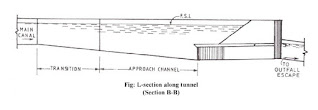 |
| L section along Canal |
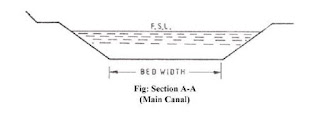 |
| Main Canal |






No comments:
Post a Comment
If you are getting more information from civilengineerfriend page please give your comments. Share the page information in your whatsapp group. Subscribe our page to get more information.